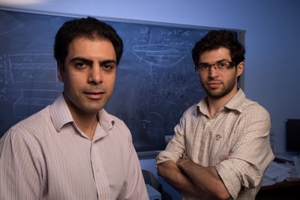Jul 16 2014
A three-dimensional porous nanostructure would have a balance of strength, toughness and ability to transfer heat that could benefit nanoelectronics, gas storage and composite materials that perform multiple functions, according to engineers at Rice University.
 Rouzbeh Shahsavari, left, and Navid Sakhavand used computer simulations to predict the properties of a 3-D nanostructure made with boron nitride. (Photo by Jeff Fitlow)
Rouzbeh Shahsavari, left, and Navid Sakhavand used computer simulations to predict the properties of a 3-D nanostructure made with boron nitride. (Photo by Jeff Fitlow)
The researchers made this prediction by using computer simulations to create a series of 3-D prototypes with boron nitride, a chemical compound made of boron and nitrogen atoms. Their findings were published online July 14 in the Journal of Physical Chemistry C.
The 3-D prototypes fuse one-dimensional boron nitride nanotubes and two-dimensional sheets of boron nitride.
"We combined the tubes and sheets together to make them three-dimensional, thus offering more functionality," said Rouzbeh Shahsavari, assistant professor of civil and environmental engineering and of materials science and nanoengineering, who co-authored the paper with graduate student Navid Sakhavand. In the 3-D nanostructure, the extremely thin sheets of boron nitride are stacked in parallel layers, with tube-shaped pillars of boron nitride between each layer to keep the sheets separated.
Shahsavari noted that in the one-dimensional and two-dimensional versions of boron nitride, there is always a bias in directional properties, either toward the tube axis or in-plane directions, which is not suitable for widespread 3-D use in technology and industrial applications.
For example, a one-dimensional boron nitride nanotube can be stretched about 20 percent of its length before it breaks, but the 3-D prototype of boron nitride can be stretched about 45 percent of its length without breaking.
When the typical one- or two-dimensional boron nitride materials are stretched in one direction, they tend to shrink in the other perpendicular directions. In the 3-D prototype, however, when the material stretches in the in-plane direction, it also stretches in perpendicular directions. "Here, the junction between the tubes and sheets has a unique curve-like structure that contributes to this interesting phenomenon, known as the auxetic effect," Shahsavari said.
The thermal transport properties of the 3-D prototype are also advantageous, he said. The one-dimensional boron nitride tubes and two-dimensional sheets can carry heat very fast but only in one or two directions. The 3-D prototype carries heat relatively fast in all 3-D directions. "This feature is ideal for applications that require materials or coating with the capability of extremely fast thermal diffusion to the environments. Examples include car engines or computer CPUs where a fast heat transfer to the environments is critical in proper functioning," Shahsavari said.
The 3-D boron nitride prototype has a very porous and lightweight structure. Each gram of this Swiss cheese-like structure has a surface area equivalent to three tennis courts. Such a high surface area lends itself to customized applications. Shahsavari and Sakhavand predicted that the 3-D prototype of boron nitride would allow efficient gas storage and separation, for example, in vehicles that run on hydrogen cells.
Unlike graphene-based nanostructures, boron nitride is an electrically insulating material. Thus, the 3-D boron nitride prototype has a potential to complement graphene-based nanoelectronics, including potential for the next generation of 3-D semiconductors and 3-D thermal transport devices that could be used in nanoscale calorimeters, microelectronic processes and macroscopic refrigerators.
The actual 3-D boron nitride prototype still has to be created in the lab, and numerous efforts are already underway. "Our computer simulations show what properties can be expected from these structures and what the key factors are that control their functionality," Shahsavari said.